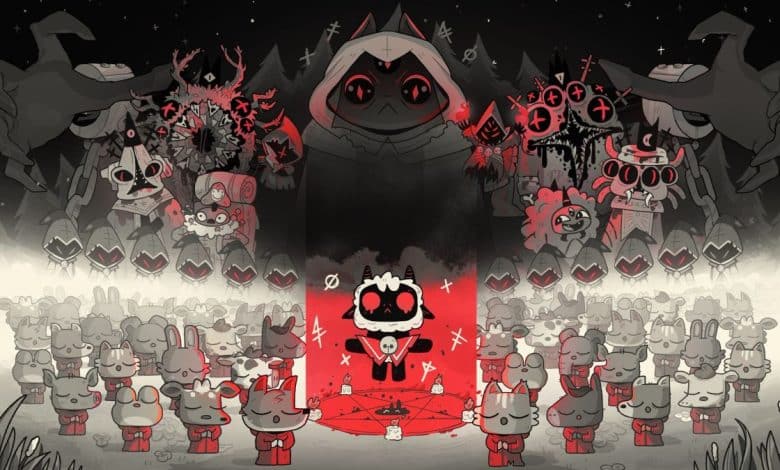
CULT OF THE LAMB
Cult of the Lamb (CotL), developed by Massive Monster and published by Devolver Digital, is a mix of roguelite arena brawler and city (okay, village) builder/God game. Definitely imaginative as an idea, it remains to be seen how it fared in implementation. August is a lazy month in many ways, and game releases are usually no exception. However, certainly at the time of writing this CotL is the indie sensation of the day, and has climbed to the top of sales and twitch views.
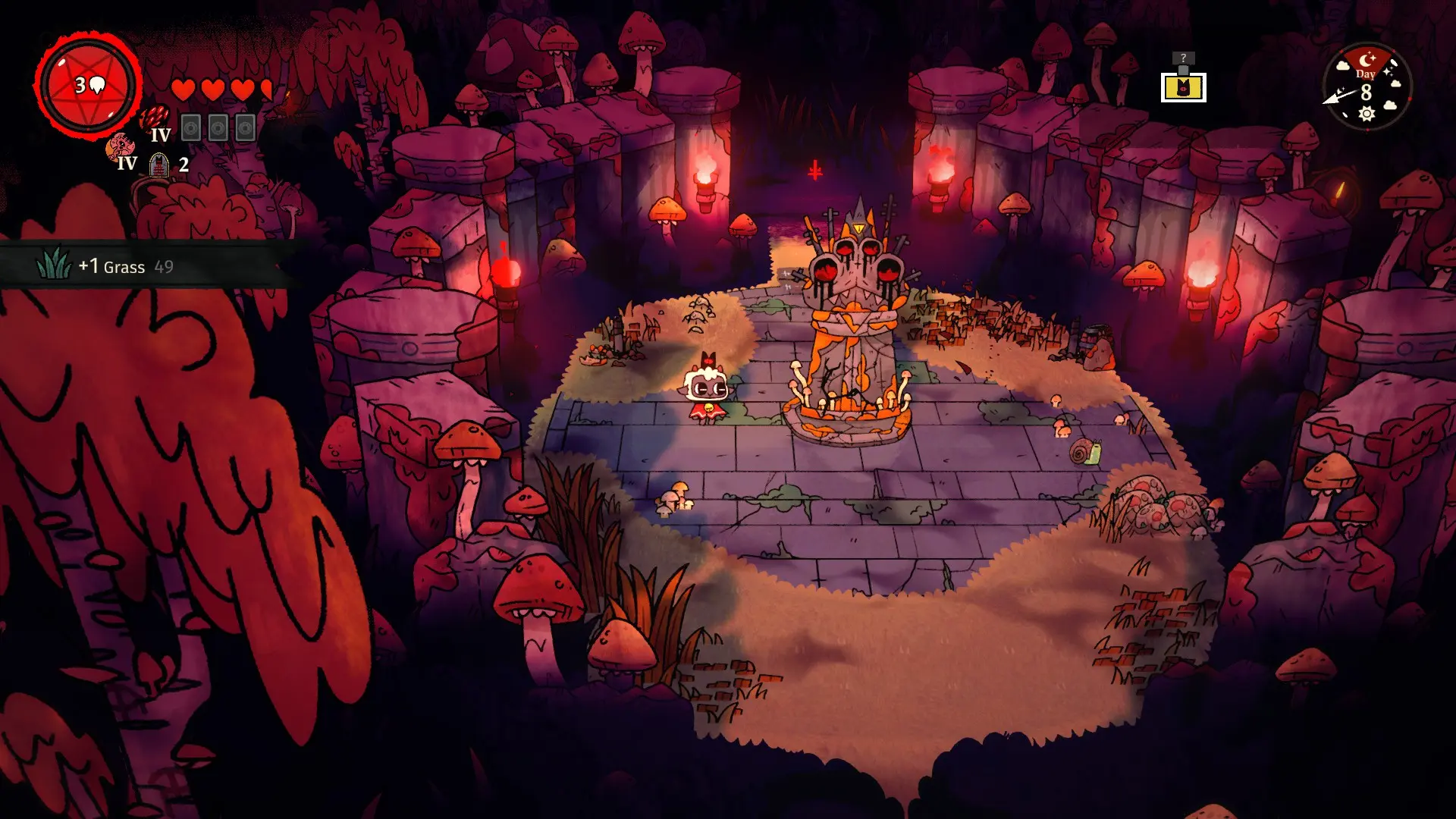
Central to this is the superb visuals, with the dark comic aesthetic and attention to detail in the animation being used for a seminar. It's literally made to be gawked at, and its huge streaming success is no accident. The audio doesn't impress in the same way, but that's not to say that it doesn't perform at a high level. A special mention goes to the voice overs, which manage to add colour to the unintelligible speech spoken by the game's characters (with full English translation in speech bubbles of course).
It's hard not to notice a certain pattern in recent indie/AA releases. I won't even comment on the fact that we're still an adorable little animal, a fluffy and fat lamb in this case. But that we're still the last creature of our kind in all of creation goes a long way!
This happened according to plan. The four Bishops of the Old Religion are in charge of the whole world, but they dread the prophecy that says that a single lamb will be the occasion for the release of the One Who Waits, who will bring destruction. They have come up with a simple solution. To kill all the lambs of the world, so that the prophecy cannot be fulfilled.
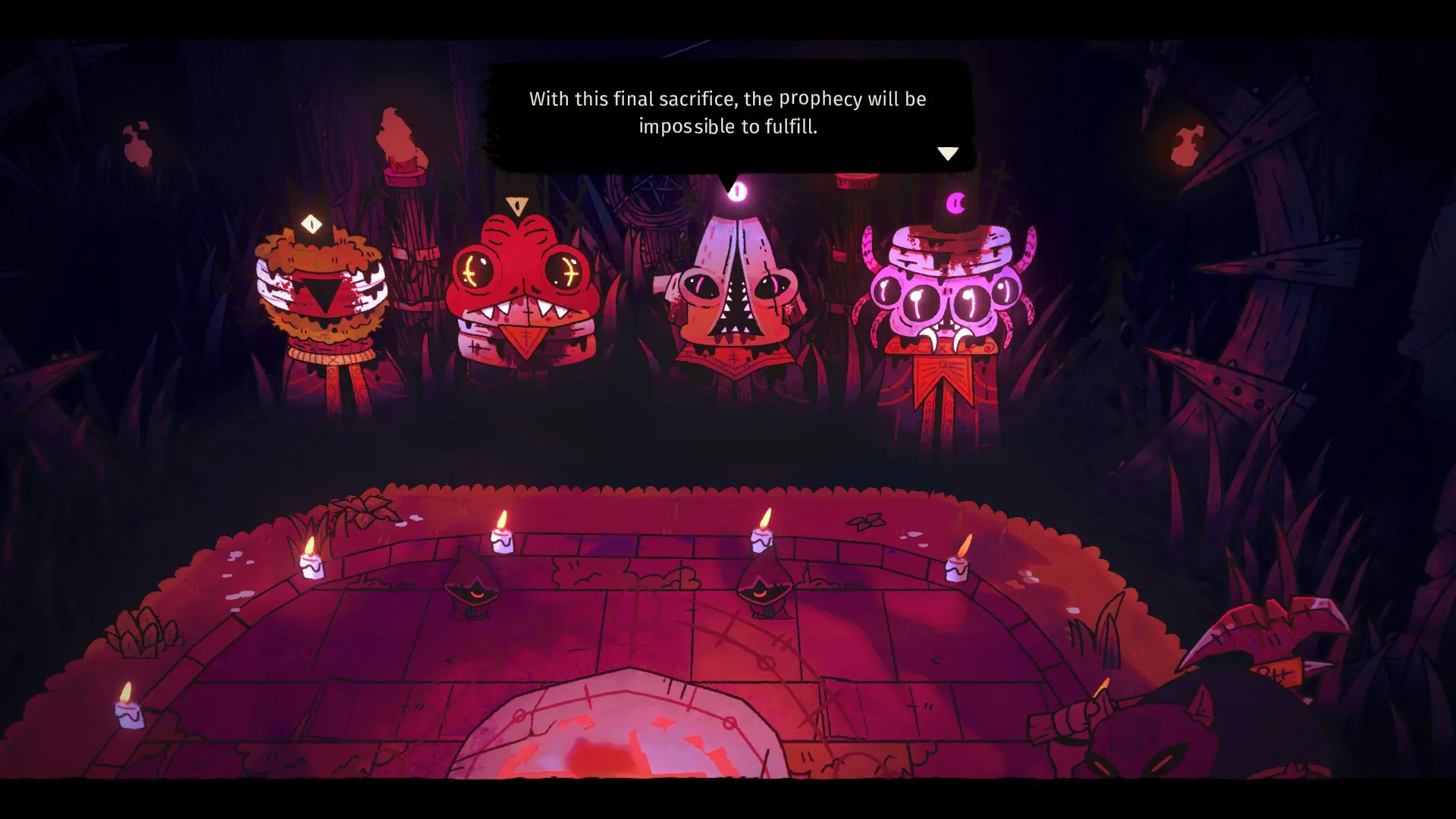
So we have been given to be the last lamb left, and CotL begins with us as a submissive lamb heading for our slaughter before the Bishops, which slaughter is successfully completed in order. So is it all over? No, because the One Who Waits may be exiled and iron-bound, but He remains all-powerful. He gathers our souls and tells us straight. He will resurrect us and give us the awesome Red Crown, with the help of which we will be transformed from a mere lamb into a most capable warrior-magician. In return, we must establish a new religion in his name, gather followers, and kill the Bishops who stand in the way of the liberation of the One Who Waits.
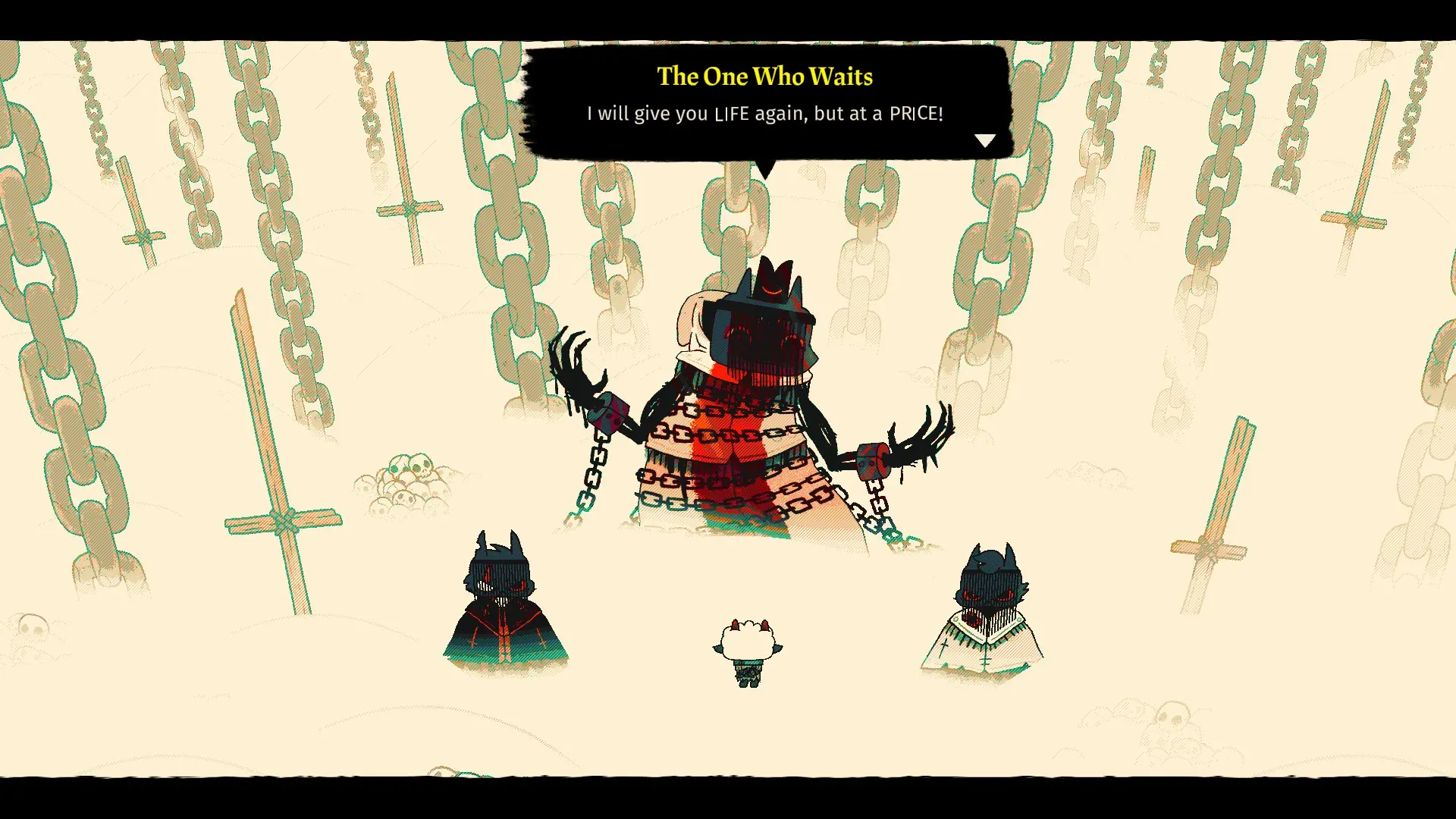
At this point the game actually begins, which is divided into two distinct parts, however much they interact with each other. One is the pure roguelite brawler part, which will look familiar to anyone who knows what games like Binding of Isaac are. The path to each Bishop is a series of procedurally generated one-screen combat arenas, where random enemies spawn, each with different movement patterns and attack sets. At the start of each combat run, we're given a random weapon and a random utility spell - there's always the possibility of finding others during the run, but it's not a given. These are the tools we have available to kill our enemies, always on the way to the boss. As we succeed, we also collect various resources at the same time, both material goods and Followers, which are useful for building our village - but more on that later
Melee combat plays a prominent role in the battles, with ranged options only giving some of the utility spells. CotL's mechanics in this aspect are simple but solid. With a dodge roll always available to avoid enemy attacks, the initial, and fairly easy, difficulty curve lies mainly in getting used to the attack speed of each weapon - to whoever manages to win, not just a run, but an entire screen with the warhammer, my sincere respects. If we get killed, we lose some of our resources and can either try again immediately, or make sure we get stronger before we come back stronger.
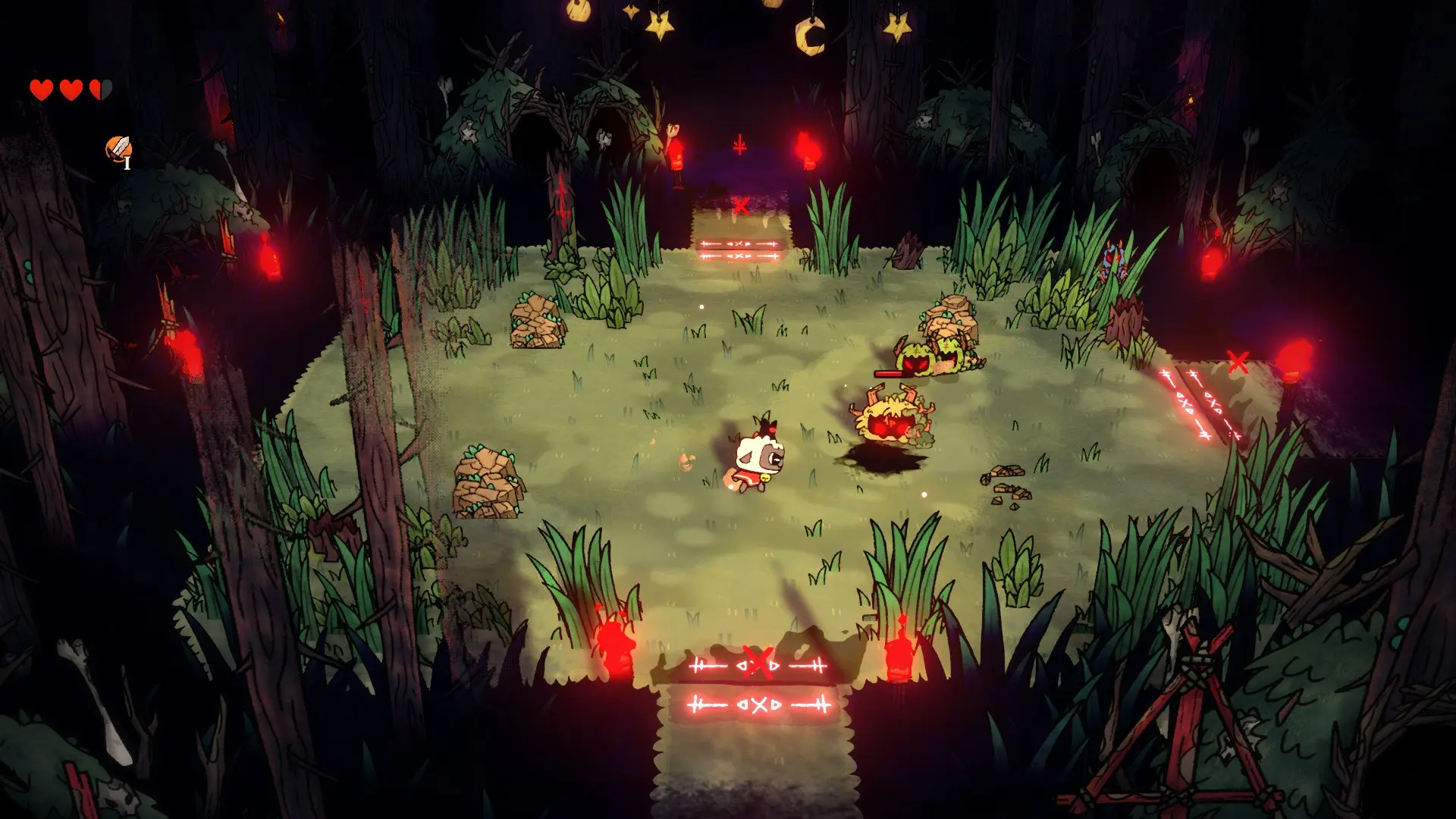
If we decide that we prefer empowerment (the wisest option while it's available - more on that later), we enter the cult management part of the game. Starting out, we are inherited with a relatively spacious fertile valley, in which we can begin building the village that will house the Followers of our new (and one true!) religion. The most important buildings, of course, are the totem where the faithful worship in our Name, and the Church where we care for the faith of our Followers and perform the rites of our (one true!) religion. These are the basics, but to be able to set up a decent religion business, we will need to provide at least the bare essentials for the livelihood of those who follow us - and if we decide to be Enlightened Despots, a few luxuries as well.
So, we need to set up kitchens for cooking, but also farms to provide the ingredients for the food. Also at least a few straw mattresses, which later if we feel like it we can upgrade them up to lux huts with everything. A First Aid tent always helps, especially if we have not yet taken care to provide a latrine and a closet with cleaning supplies in our village - in that case, we will soon find ourselves literally swimming in excrement, although there is a solution for everything. Of course they are first-class fertilizer for our farms, but if we prefer a more tyrannical way of governing, there is always the option of ordering the faithful to eat them, and anyone who doesn't like them can be the next to be completely randomly sacrificed to the Dark Gods. Such practices can of course lead some believers to either an early death, in which case some graves are useful, or worse, to a questioning of our Authority, which if not dealt with quickly (good or bad), will lead to withdrawal from the (only true!) religion.
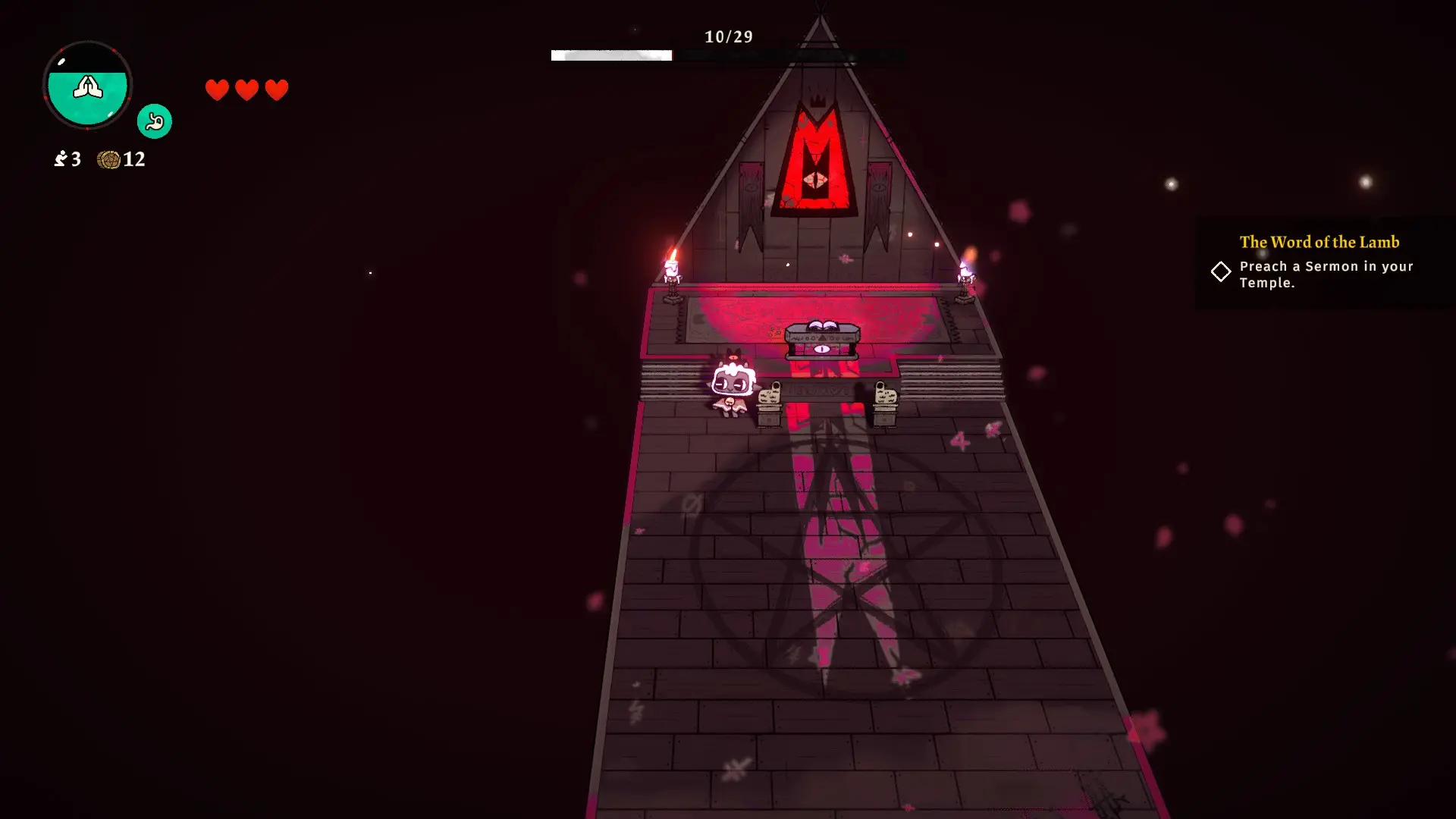
Somewhere here it is impossible not to notice that the new religion that worships us as a representative of the One Who Waits is, shall we say, of dubious morality. Okay, a little coprophagy is fun to laugh at, but what is that upside-down pentagram at the center of the Church, and what creature do the huge tentacles that come out of it end up being whenever we sacrifice a believer to increase our powers? And for that matter, what kind of religion has rituals of sacrificing believers to increase the High Priest's powers? But don't you get bored, you think the Old Religion was any better? Especially since it killed all of our kind!
The main advantage we have as High Priests (besides the fact that it is never ceases to be fun to feed the world with sh... sophisticated recipes) is that our faithful produce both Faith and Worship (yes, they are different). With Faith we can gain access to new buildings, and their upgrades, for our village, but with Worship, we upgrade the arsenal of weapons available to us in combat runs. So, at some point, we go from the rusty socketed daggers and half-smoked fireballs we start with, to having access to Godly War Axes and Divine Tentacle Eruptions. Also, some collectibles from runs can provide some damage and health upgrades, accompanied by some disadvantage, so we can turn them on or off at will while we're not in a run. A good combination can greatly increase the value of our lamb, which will soon prove necessary.
I've given a detailed description of almost all of the game's mechanics - I've left a few things for you players to discover for yourselves. Before I move on to my evaluation of CotL, I'll just mention that I played on the medium difficulty level, which is what the game itself recommends to new players.
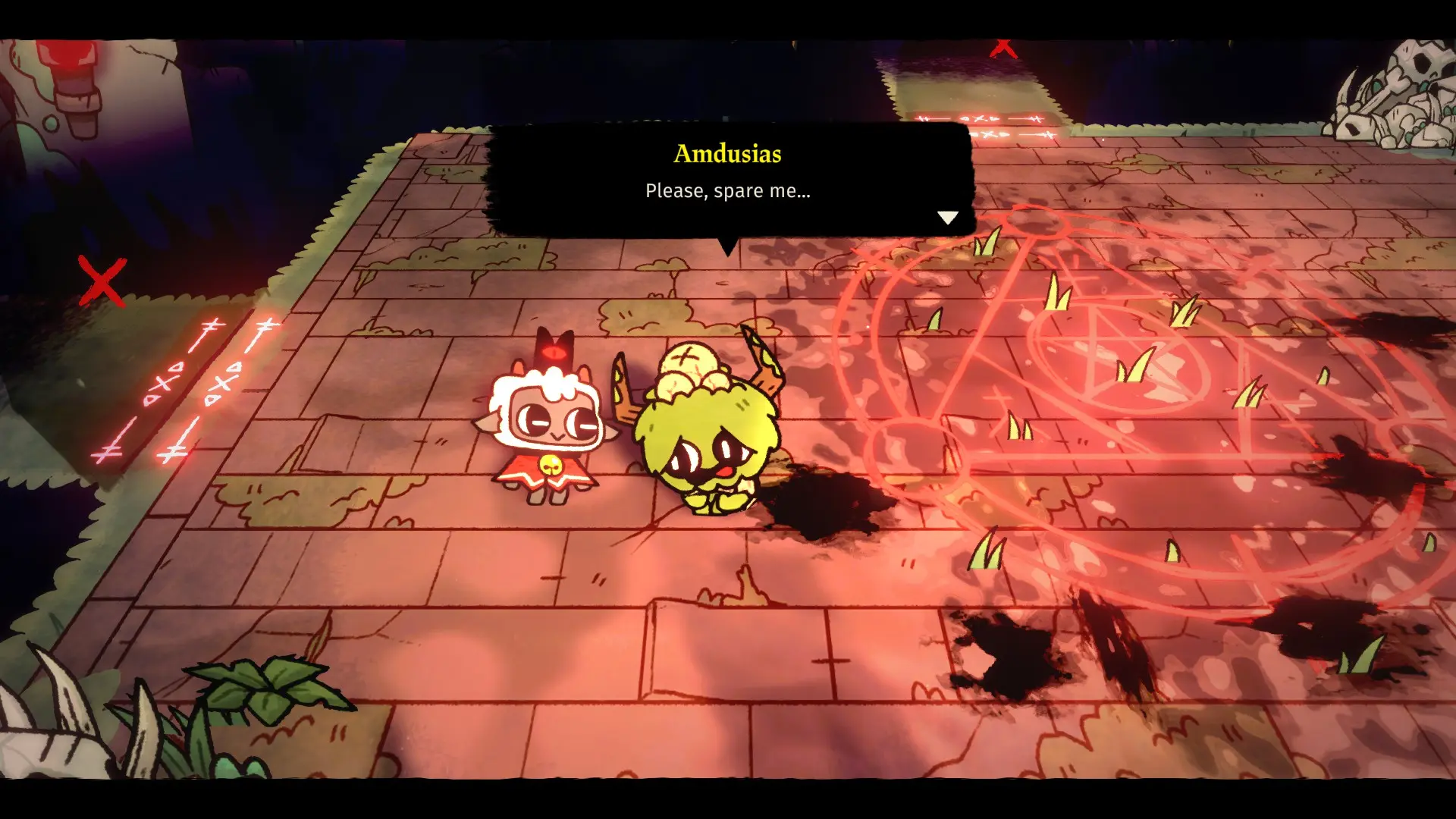
For the first eight hours of the game, I was convinced I was playing Game of the Year 2022. The game's sardonic humour gave me a constant grin of pleasure, the utterly elusive setting with great novelty value drew me in to explore everything, the gameplay loop in both cult management and combat runs had me completely absorbed, and I couldn't tear myself away. Somewhere in there though, which is almost exactly halfway through CotL, the problems started to become apparent, mostly related to balancing, both in between cult management and combat running, and the difficulty in the battles themselves.
The way I played the game, with moderate grinding of the first areas to strengthen my character a little bit because I started to find the battles tough rather quickly, I "ran out" of cult management content at about ten hours, while I had barely managed to kill the second Bishop. My village had practically all of the essentials, almost all of the cosmetics, and most importantly, I now had access to the most powerful weapons and spells in the game... and I was still struggling in battles trying to reach the third (of four, mind you) Bishop.
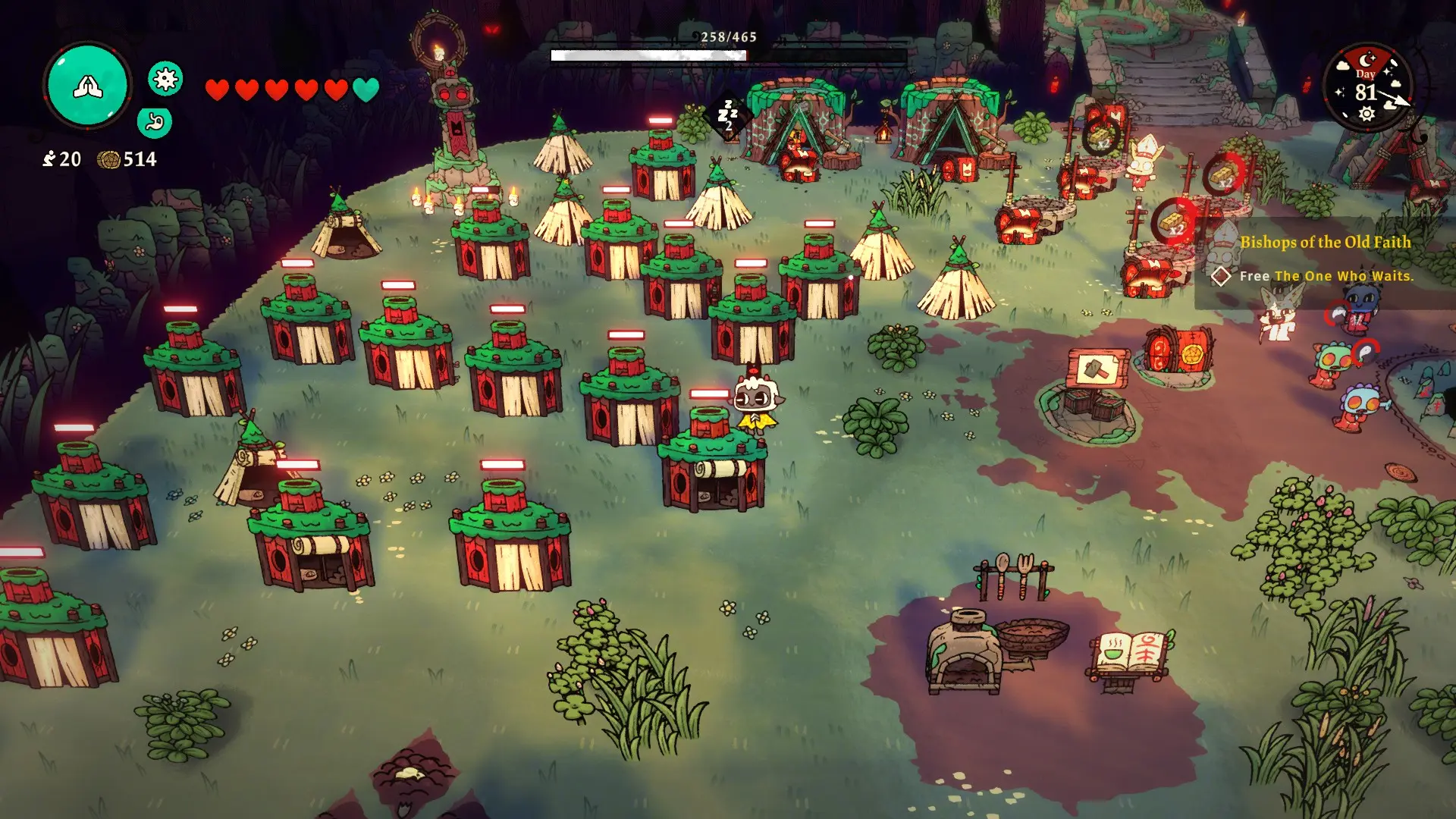
One component of the increased difficulty is due to some difficulty spikes that were sometimes created by unfortunate (for me) enemy/terrain combinations resulting from procedural generation. There is another component though, which does not include the luck factor but is a clear design decision, and that is that very soon after the death of the first Bishop, enemies take a lot more beating than I think they should in the medium difficulty setting, even if you're holding very powerful weapons.
This can only be overcome in two ways. One is based on luck, through upgrades to attack speed and damage that can only be gained for that specific run, via tarot cards acquired within. If strong combinations favour us, fine, otherwise the Ferocious Necromantic Sword XVI we're most likely wielding can barely scare a bat; their dive attack makes them one of the most troublesome enemies. The other way is the old-fashioned "git gud". With proper observation of enemy attack patterns, perfect timing on our dodge rolls, and great restraint to not overextend our counterattacks, we still can't do much damage, but at least we win almost unscathed and can move on. Generally speaking, I would have no problem with this. In CotL though, firstly the huge change from the more hilarious "dude" combat in the first area is pretty abrupt, and secondly it makes the empowerment part through cult management feel anemic and unfinished.
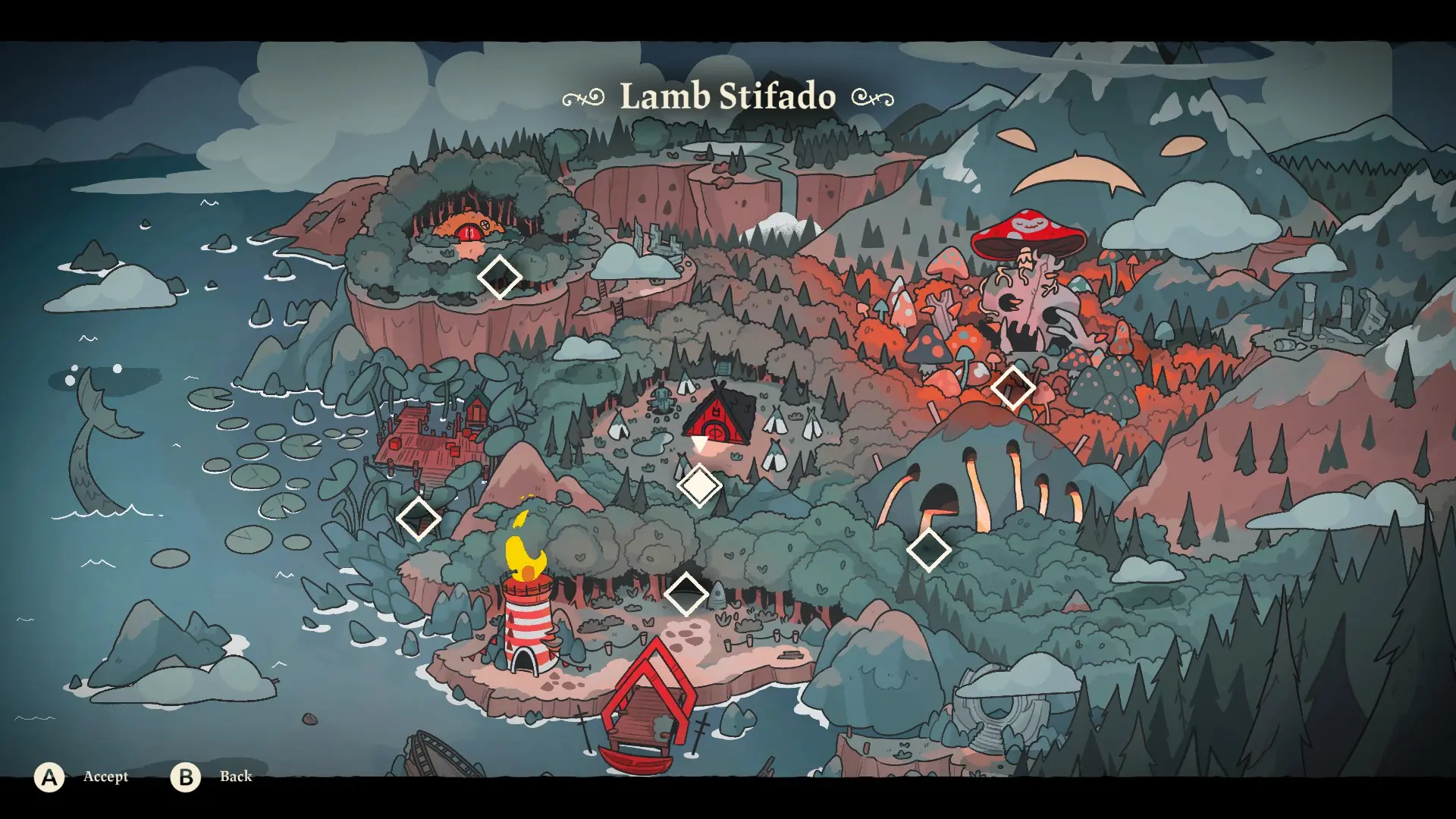
With the watering of the first few hours encountering at least temporary skill gates, CotL's minor problems start to become more apparent. One of the already limited variety of weapons is really useless (spoiler, the hammer). Sometimes the arenas have such dense decorative elements (grass, cobwebs, crystals) that you can't see what's going on. In Church we often have to choose between two available permanent unlock rituals, many of which are patently much more useful than their alternatives. The abandon run ability is an excellent Quality of Life feature that should be available by default, not just as an upgrade with an extremely rare resource.
Even if we are the most benevolent High Priests in the world and take care of the welfare of our faithful, they die of old age irritatingly fast. If one of the faithful loses his faith and starts preaching heretical views, theoretically we can bring him back to the Unique Truth, practically this is so difficult that it is better to somehow get rid of him. At the highest level of development, our village is almost self-sufficient, but some options shine through their absence - our believers can neither cook nor go to the First Aid tent on their own.
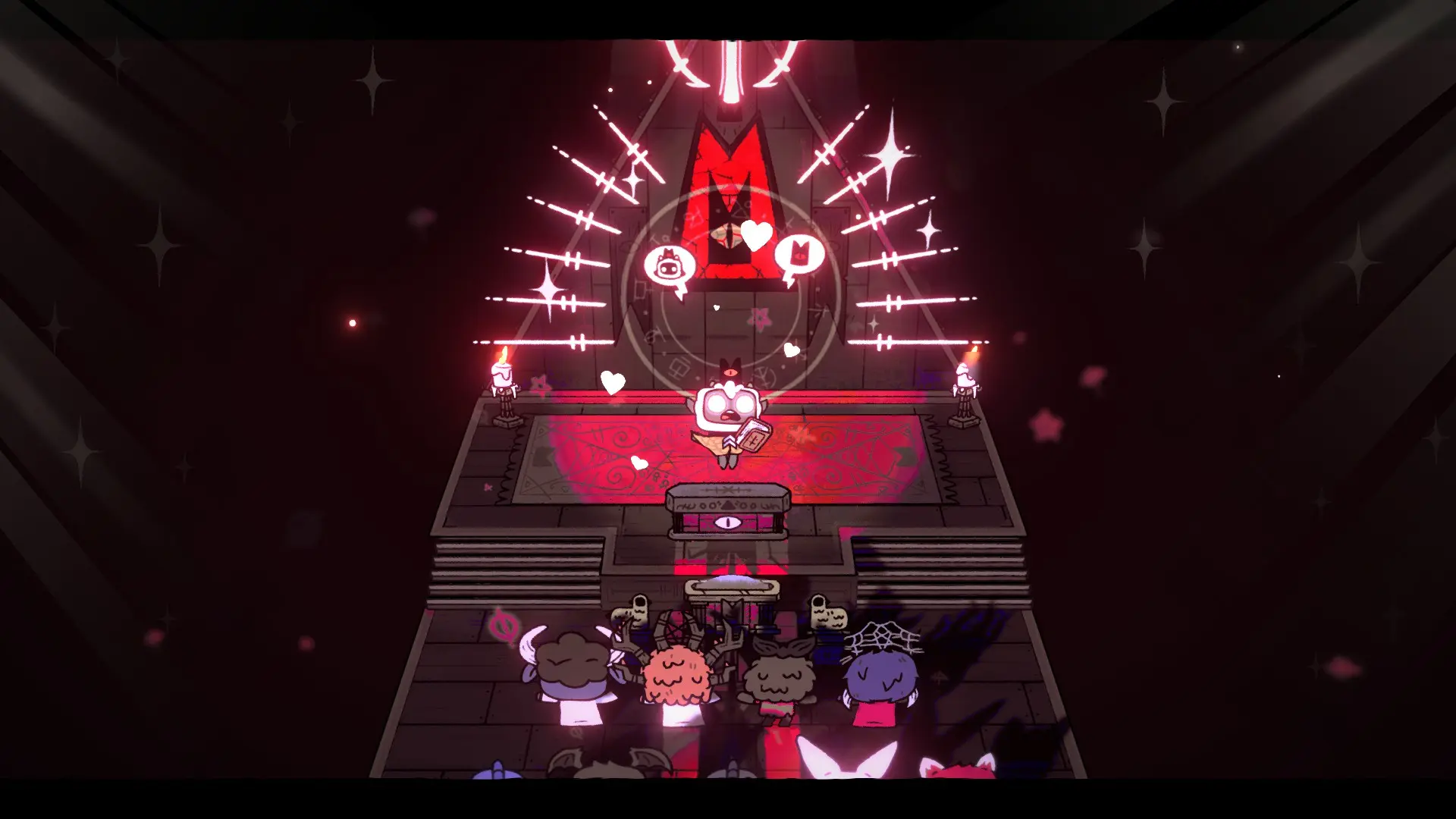
However, despite this, and despite my initial excitement having been tempered, CotL had now put me firmly in its world. My cult had long since gone on autopilot, with the exception of the cooking theme (for anyone who has endured reading this far, I'll give it away - unlock Ritual of Feasting as soon as possible), but it was still fun to watch my faithful flock back and forth between the upgraded buildings and decorative monuments, if only for a little while. And there was no way I was going to give up before I made the last Bishop bitterly regret slaying me.
Even when I wasn't playing, I would sit and think about which combinations of weapon-early tarot cards were worth fighting a run with, or is it better to just abandon and try again from the beginning. Finally, after about eighteen hours, with persistence and patience, I had completed my revenge and the game's story. After that, the game lets you do endless runs to see how far you get, but for me personally, that kind of thing is of no interest. I kept going until I collected some collectibles and my involvement with CotL came to an end.
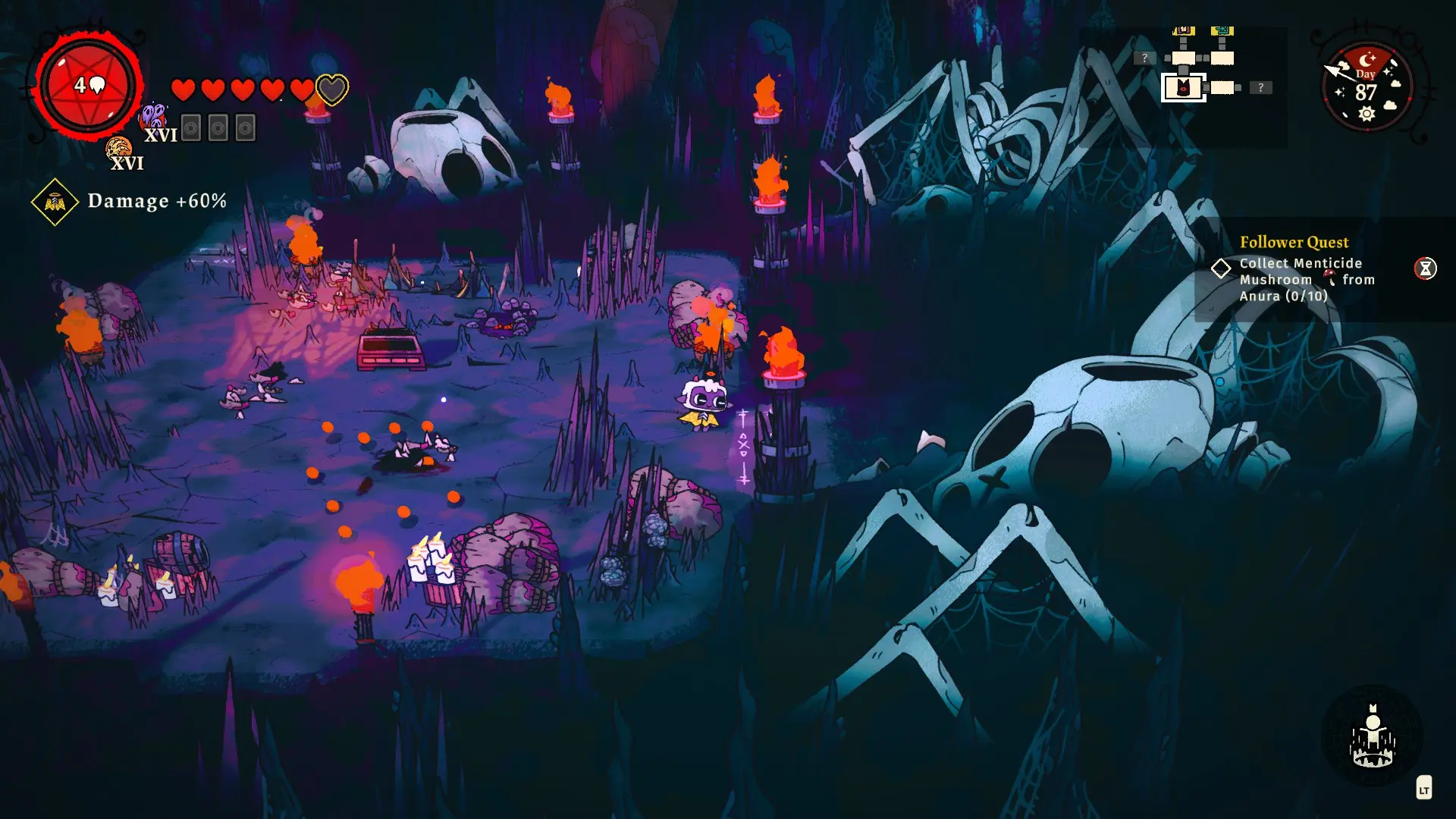
There is no doubt that the overall impressions for Cult of the Lamb are positive. The charm of its gorgeous visuals can't hide existing balance problems and lack of content compared to some pure roguelites, but there's also enough substance for a thoroughly entertaining fifteen to twenty hour playthrough, depending on the player's skill level.
RATING - 83%
83%
Baa-lzebub!
A truly unexpected and ultimately successful mix of roguelite combat and city management. Aside from the remarkable gameplay, the excellent aesthetics also provide pure watching entertainment value, from which some balance issues can't be taken away.











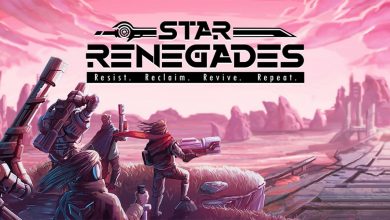
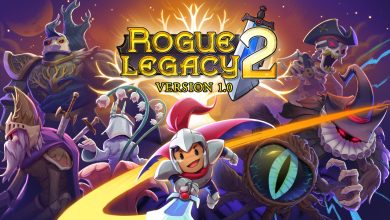



Happy Tree Friends: Satanic Panic Edition
Αναλυτικότατος και με έπεισες απόλυτα να [U]μην[/U] το αγοράσω.
Πλην του Hades, που ήταν αριστούργημα, με κουράζουν τα roguelites, οπότε με αυτά που διαβάζω, είναι ξεκάθαρο pass.